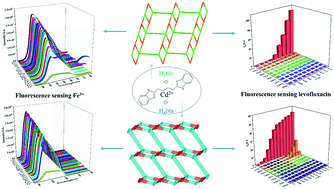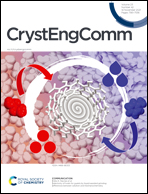Two Cd(ii)-based metal–organic frameworks for the highly effective detection of Fe3+ ions and levofloxacin in aqueous media†
Abstract
Levofloxacin (LVX), as a broad-spectrum antibiotic, is ubiquitous in water environments due to its wide application and good water solubility, posing a certain threat to the ecological environment. Therefore, it is necessary to design a fluorescent sensor with an effective detection ability. In this work, two new Cd(II)-based metal–organic frameworks (MOFs) [Cd(L)0.5(tdc)·H2O]n (1) and [Cd(L)0.5(btec)0.5]n (2) (L = 1,4-di(1H-benzo[d]imidazol-2-yl)butane, H2tdc = 2,5-thiophenedicarboxylic acid, H4btec = 1,2,4,5-benzenetetracarboxylic acid) were hydrothermally synthesized and characterized. 1 presents a 2D hierarchical layer with a 3,4L83 network, whereas 2 exhibits a 3D framework with fsh topology. The two Cd(II)-MOFs exhibit superior thermal and chemical stability (pH = 3–12). 1 and 2 can selectively identify LVX with ultra-high sensitivity (0.01 μM and 0.02 μM), rapid response (in 30 s) and excellent selectivity in water. Meanwhile, 1 and 2 also can be efficient probes for detection of Fe3+ ions with detection limits of 1.08 μM and 1.74 μM, respectively. Moreover, the two dual-response luminescent sensors exhibit remarkable reusability. The quenching mechanisms were also investigated from the perspective of energy transfer and photoinduced electron transfer (PET) in detail.

- This article is part of the themed collection: Crystal Engineering Techniques


 Please wait while we load your content...
Please wait while we load your content...